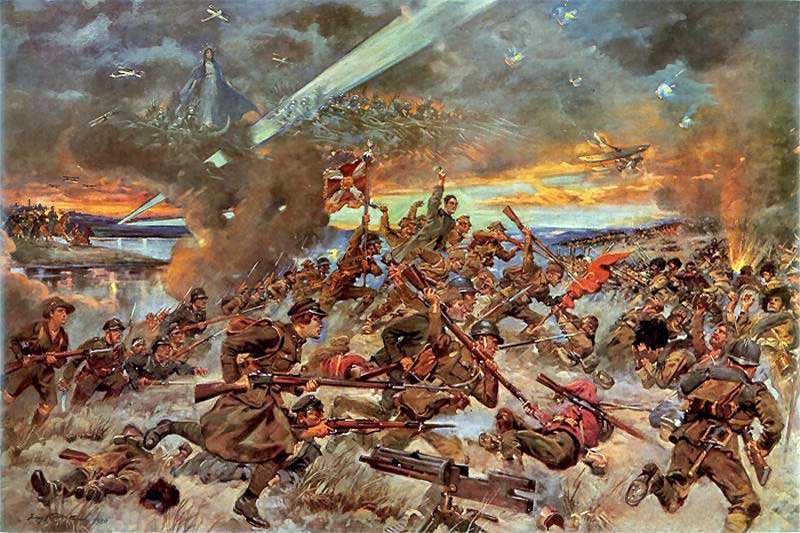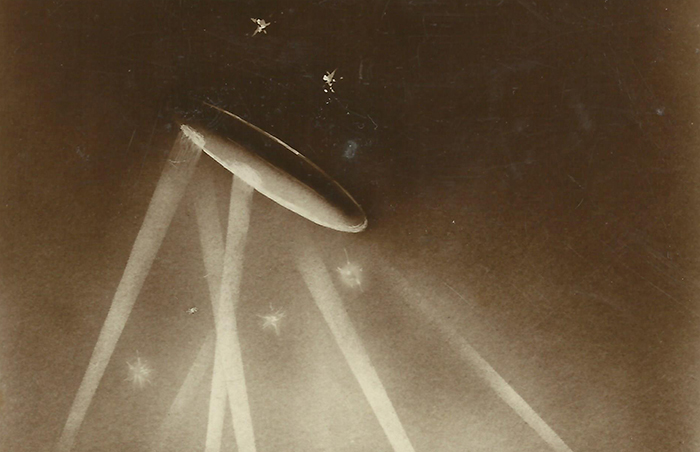
“The first three years of Poland’s existence were marked by a constant state of war, conflicts fought almost simultaneously against and array of enemies.”
THE MODERN STATE of Poland was born out of the geopolitical turmoil that marked the final days of World War One. And not surprisingly, its first years in existence were equally tumultuous.
In the autumn of 1918, Eastern Europe was in a state of chaos. Russia was embroiled in civil war, Imperial Germany was in its death throes and the centuries-old Austria-Hungarian Empire was disintegrating.
By early November, Polish nationalists in Warsaw, Krakow and elsewhere finally saw their chance for independence after 120 years of foreign rule. A provisional government seized power and hastily fused the modern state of Poland together out of parts of Germany, Russia and Austria Hungary. Meanwhile, a national army was assembled almost overnight out of Polish regiments of serving in the militaries of the Central Powers and Russia.
The first three years of Poland’s existence were marked by a constant state of war, conflicts fought almost simultaneously against and array of enemies. The clashes would pit Poland against other states of Eastern Europe, they would result in diplomatic and military intervention from the French, British Italians and Americans, and would very nearly lead to the collapse of the Polish homeland itself. Here’s a recap of the action.

War In Ukraine
The first shots of Polish independence were fired in the former Austria-Hungarian region of Galicia in early November of 1918. With the Habsburg monarchy collapsing, Western Ukrainian nationalists declared an independent republic. Opposing them for control of the region was a small faction of ethnic Poles who weren’t about to trade Austrian rulers for Ukrainian ones. Although outnumbered, Polish civilians in the Galician city of Lviv resisted the Western Ukrainian army’s attempt to seize control of the area. Other uprisings broke out in nearby towns. Fighting persisted for two weeks, at which point regular troops from the newly independent Polish republic arrived to relieve Lviv and incorporate Galicia into the new country. The Polish force drove the enemy off and even succeeded in grabbing the nearby Drohobych oil fields. The Western Ukrainians would return with help from the much larger Ukrainian People’s Republic to the east and fighting between Poles and Ukrainians would continue until early 1919. That’s when French envoys pressed Ukraine to cease and desist. The Ukrainians ignored Paris’ demands and continued to to wage war for Galicia. France responded by arming Poland and dispatching the 60,000-strong Blue Army, the brigade of ethnic Poles that had fought on the Western Front in World War One. The fighting in Galicia raged throughout 1919, ultimately claiming a total of 25,000 lives. By year’s end, the shaky Western Ukrainian Republic threw in the towel. Meanwhile, Kiev, with the Bolshevik Red Army on its eastern border, also agreed to cede control of Galicia to Poland for 25 years. Amazingly, the ink was barely dry on the ceasefire agreement before the Ukrainians were pleading with Warsaw for help against a much greater foe: Soviets armies massing in the east. Soon, the two former enemies would team up to take on the Bolsheviks.

Confronting Germany
While Poles were doing battle with Ukrainians, Polish forces elsewhere were busy carving out new territory in German controlled Poznan in the north and west. This separate war, known as the Polish Uprising, was launched by the nascent national army in December 1918 amid the chaos of the post war German Revolution. 
Clashes between the Poles and war-weary German troops continued well into 1919. Eventually, much of the territory Poland occupied in Upper Silesia and West Prussia, including Danzig, were formally awarded to Warsaw in the 1919 Treaty of Versailles. The fighting didn’t end there though. Additional rebellions in Silesia would continue into 1921 resulting in even more German land going to Poland. Twenty years later, the Nazis would seek revenge for these incursions.

The Seven-Day War
Less than three months after declaring independence, Poland would find itself tangling with yet another foe: the newly independent republic of Czechoslovakia. The brief war, which claimed 1,000 lives in January of 1919, was inaugurated by Prague to prevent ethnic Poles in the tiny border enclave of Cieszyn Silesia from joining the recently established Polish republic. The Czechoslovakian army attacked the small region on Jan. 23 with several thousand reservists and veterans of Austria’s Italian campaign as well as a unit of Czech riflemen who had served in the French Army during World War. Poland, already fully engaged fighting Germans and Ukrainians, had no choice but to give ground. British, French, Italian and American military observers in the region quickly called on the Prague government to call off the offensive after just a few days of fighting and pressed both parties to meet at the peace table. The disputed zone was placed under control of the western powers until a treaty in 1920 between the two countries formally partitioned the region.

Poland (and all of Europe) in the Balance
Poland’s wars in Ukraine and Germany as well as its clashes along the Czechoslovakian border all paled in comparison with its epic showdown with Soviet Russia in 1919 and 1920. The war began as a series of minor clashes in what is now Belarus between a Polish force of 50,000 troops and elements of the Red Army. In these first encounters during the summer of 1919, it was the Red Army that gave ground — the Soviets, still busy fighting their own internal civil war, had little appetite for a confrontation with Poland. But by early 1920, Moscow had largely crushed resistance at home and was now ready to expand.

Red Army commanders planned to secure Belarus, march into Poland itself and if all went well maybe ‘liberate’ the whole of Europe in the name of communism. In the spring of 1920, 800,000 Soviet troops launched a massive assault westwards along a 200-mile front. It handily crushed the forces of both the Ukrainian republic and sent the Poles reeling from Belarus and back towards their homeland. By August, the Russians had absorbed the whole of the Ukraine and were threatening Warsaw itself.
By the end of the month, the Polish capital was under Soviet guns. The Bolsheviks expected a quick victory and then planned to push on to Berlin, Paris and beyond. Desperate, the Poles regrouped for one last-ditch counter attack. The Battle of Warsaw (also known as the Miracle on the Vistula) saw a force 120,000 of Polish troops crash into the southern flank of the Red Army at the gates of the city. The Soviets suffered a humiliating defeat, losing 25,000. The loss touched off a speedy Russian retreat eastwards. The Poles pursued, evicting the Bolsheviks from Poland entirely in a matter of weeks. In October, a ceasefire was declared; by the following year, a formal peace treaty was signed. Poland would be spared for the time being, but like the Germans, Moscow longed for revenge. They too would have it in 1939.

Lithuania
A sideshow of the larger struggle against the Soviets was Poland’s war with Lithuania. The conflict began in the spring of 1919 when a detachment of Polish troops invaded the Baltic region. Polish troops grabbed the towns of Suwalki, Agustow and Sejny and even drove into the capital of Vilnius. The advance was called off however when the Soviets surged into Poland in 1920. The Poles abandoned Lithuania and withdrew to defend their own capital. After the Russians had been beaten back following the Battle of Warsaw, a force of 20,000 Poles returned to reclaim Warsaw’s prizes in Lithuania. The tiny Baltic republic mustered a defence force less than half that size but resisted stubbornly. They were soon reinforced by 100,000 Soviet troops. The two sides fought a ten-day battle at the Niemen River in September of 1920. The Poles crushed both the Soviets and Lithuanians and likely would have absorbed the whole of the area had it not been for the intervention of the League of Nations, which called upon Warsaw to stay its forces. Poland withdrew but would keep Suwalki, Agustow and Sejny.
Poland’s Attempted Coup
If five wars wasn’t enough, Poland also faced the prospect of its own internal civil war in January of 1919. That’s when a coalition of right-wing National Democrats in Warsaw attempted to overthrow the socialist prime minister Jędrzej Moraczewski and his “chief of state” Jozef Pilsudski. While the rebels succeeded in arresting the prime minister, Pilsudski escaped capture and rallied loyalist forces. A counter coup netted the conspirators ending the uprising on the spot. To maintain the peace, Moraczewski invited National Democrats to join him in a coalition government.










4 thoughts on “A Traumatic Birth – How the Newly Independent Poland Fought Five Wars in Two Years”